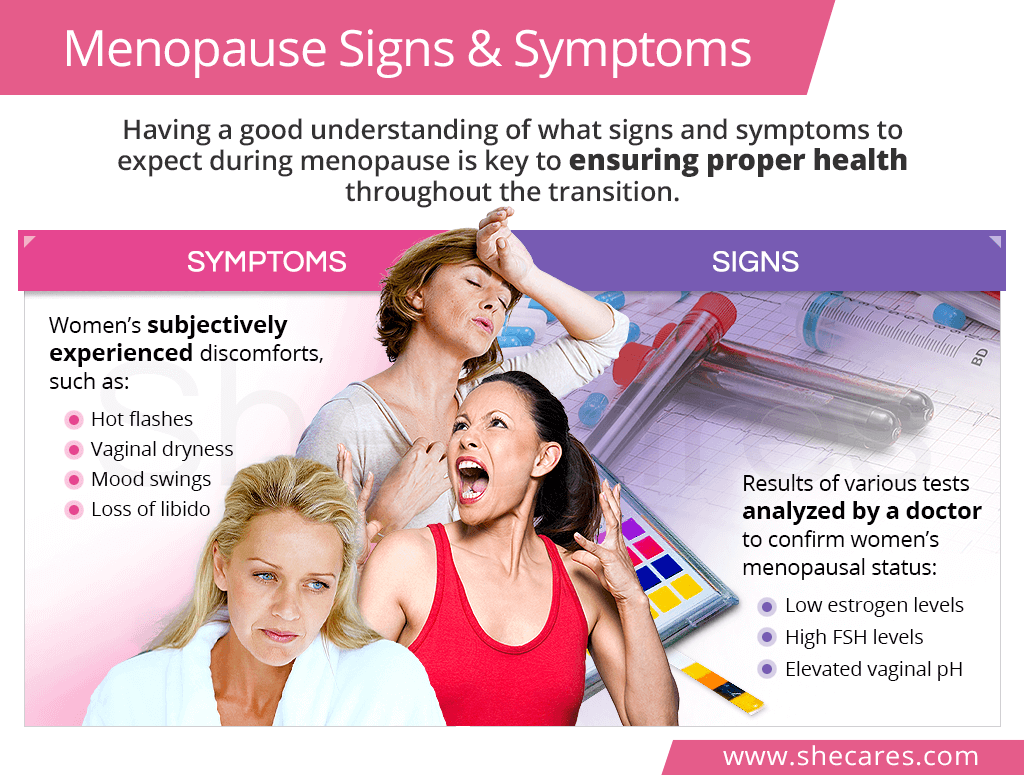Symptoms of Menopause

Menopause symptoms are the biggest nuisance of the entire midlife transition. For most women, they begin sometime in their mid-40s and hit women with varying intensities and frequencies.
The most intense symptoms happen in perimenopause, or the years leading up to a woman's last period. However, some menopause symptoms - though generally milder - may continue on to the final stage of the transition, called postmenopause.
Most Common Menopause Symptoms
From among over 30 recognized menopause symptoms, some are more common than others:
Irregular periods are oftentimes the first menopause symptom of which women take note. They may skip a few cycles, and their periods may become heavier or more or less frequent. Ovulation also tends to be irregular.
Hot flashes and night sweats are the hallmark symptoms of the menopausal transition. Their mechanism is similar, with the exception that hot flashes occur during the day, and nocturnal hot flashes are referred to as night sweats.
Loss of libido, vaginal dryness, and painful sex are commonly experienced symptoms of menopause.
Mood swings, irritability, depression, and anxiety are some of the psychological symptoms of menopause.
Weight gain, particularly around the waistline, is a very common menopause symptom that may continue - and oftentimes worsen - throughout postmenopausal years.
Other Menopause Symptoms
Other effects of menopause on the body include a variety of physical and psychological discomforts, such as:
Signs of Menopause

Contrary to symptoms, menopause signs are usually not analyzed during perimenopause because erratic hormonal fluctuations may cause significant inaccuracies.
If a woman goes through the transition at the typical menopause age (45 to 55), menopause signs are looked at once she has gone without a period for 12 months.1 Absence of menses is, coincidentally, one of the signs of menopause.
However, if a woman experiences symptoms at a younger age, menopause signs as well as the results of additional test may be obtained sooner to diagnose or rule out early menopause or premature menopause.
Absence of Periods
As aforementioned, the cessation of menstrual periods is a clear and principal menopause sign.
Before their last periods, women are likely to experience significant irregularities, which may also consist of skipping periods for a few months in a row. However, menopause arrival will not be confirmed until periods have been absent for 12 consecutive months.2
Postmenopausal Hormone Levels
Unpredictable hormonal fluctuations are characteristic of perimenopause. They do, however, stabilize once a woman becomes postmenopausal.
The cessation of periods happens because ovaries no longer contain follicles that normally store eggs and produce estrogen. As a result, estrogen levels drop drastically to 30 pg/mL and below, while follicle-stimulating hormone (FSH) levels increase to 30 IU/L or above.3,4 These altered hormonal levels are a reliable menopause sign.
Elevated Vaginal pH
Hormonal lows after menopause, particularly those of estrogen, can also affect vaginal environment, increasing the pH above 4.5.5
To prevent infections, estrogen helps maintain vaginal pH at a moderately acidic level throughout the reproductive years. When estrogen levels decrease with menopause, vaginal pH increases and becomes less acidic. Besides pH, the lining of the vagina becomes drier, thinner, and less elastic, causing uncomfortable symptoms.
Key Takeaways
Throughout the various stages of the menopausal transition, women's discomforts are likely to change quite significantly. Defined as women's subjectively experienced discomforts, menopause symptoms range from commonly reported hot flashes, irregular periods, and loss of libido to less common tingling extremities, dizziness, and electric shock sensations. Menopause signs, on the other hand, are more objective evidences doctors analyze to determine women's menopausal status. They include the absence of periods, changed hormone levels, and elevated vaginal pH. Knowing what menopause signs and symptoms they can expect can help them pass through the transition in a more calm and constructive way.
Sources
- BMC Women's Health. (2015). Prevalence of menopausal symptoms among mid-life women: findings from electronic medical records. Retrieved March 18, 2021 from https://bmcwomenshealth.biomedcentral.com/articles/10.1186/s12905-015-0217-y
- BreastCancer.org. (2020). Tests to Determine Menopausal Status. Retrieved March 18, 2021 from https://www.breastcancer.org/tips/menopausal/types/determine-status
- Harvard Health Publishing. (2015). Menopause-related hot flashes and night sweats can last for years. Retrieved March 18, 2021 from https://www.health.harvard.edu/blog/menopause-related-hot-flashes-night-sweats-can-last-years-201502237745
- JAMA Internal Medicine. (2008). Persistent Hot Flushes in Older Postmenopausal Women. Retrieved March 18, 2021 from https://jamanetwork.com/journals/jamainternalmedicine/fullarticle/414566
- Maturitas. (2020). Comparison of various menopausal symptoms and risk factor analysis in Korean women according to stage of menopause. Retrieved March 18, 2021 from https://www.maturitas.org/article/S0378-5122(20)30288-7/fulltext
- Maturitas. (2009). Epidemiology of risk factors and symptoms associated with menopause in Spanish women. Retrieved March 18, 2021 from https://pubmed.ncbi.nlm.nih.gov/19010615/
- Mayo Clinic. (2020). Menopause. Retrieved March 18, 2021 from https://www.mayoclinic.org/diseases-conditions/menopause/symptoms-causes/syc-20353397
- Menopause. (2018). Vaginal pH: a simple assessment highly correlated with vaginal morphology and symptoms in postmenopausal women. Retrieved March 18, 2021 from https://journals.lww.com/menopausejournal/Abstract/2018/07000/Vaginal_pH__a_simple_assessment_highly_correlated.9.aspx
- Saudi Medical Journal. (2010). Can vaginal pH predict menopause? Retrieved March 18, 2021 from https://pubmed.ncbi.nlm.nih.gov/20231928/
- The North American Menopause Society. (n.d.). Changes in Hormone Levels. Retrieved March 18, 2021 from https://www.menopause.org/for-women/sexual-health-menopause-online/changes-at-midlife/changes-in-hormone-levels
- University of Rochester Medical Center. (n.d.). Follicle-Stimulating Hormone. Retrieved March 18, 2021 from https://www.urmc.rochester.edu/encyclopedia/content.aspx?contenttypeid=167&contentid=follicle_stimulating_hormone
Footnotes:
- Mayo Clinic. (2020). Menopause. Retrieved March 18, 2021 from https://www.mayoclinic.org/diseases-conditions/menopause/symptoms-causes/syc-20353397
- The North American Menopause Society. (n.d.). Overview of Menopause. Retrieved March 18, 2021 from https://www.menopause.org/publications/clinical-care-recommendations/chapter-1-menopause
- University of Rochester Medical Center. (n.d.). Estradiol (Blood). Retrieved March 18, 2021 from https://www.urmc.rochester.edu/encyclopedia/content.aspx?ContentTypeID=167&ContentID=estradiol
- The North American Menopause Society. (n.d.). How Do I Know When I'm in Menopause? Retrieved March 18, 2021 from https://www.menopause.org/for-women/menopauseflashes/menopause-symptoms-and-treatments/how-do-i-know-when-i%27m-in-menopause-
- Journal of Mid-Life Health. (2014). Vaginal pH: A marker for menopause. Retrieved March 18, 2021 from https://www.ncbi.nlm.nih.gov/pmc/articles/PMC3955044/
